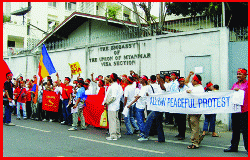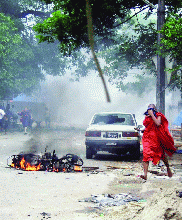Archives
Burma: When a disastrous regime continues
Thousands of survivors remain in refugee camps in the Irrawaddy Delta, nearly a month and a half after the storm devastated the region, although numbers have dropped significantly when 45 camps were set up to care for as many as 50,000 people. The government has continued to attempt to force or cajole people out of the camps and send them home, offering transport and provisions. However, for the survivors, the storm was so destructive that there are no homes, indeed in some places not even towns to go back to.
 Since August 2007, the country has remained the focus of outraged international headlines, and for good reason. Hundreds of thousands of Buddhist monks and common people took to the streets nearly a year ago, raising their voices against the State Peace and Development Council, as the junta calls itself, only to be crushed. About 100 people are thought to have died and thousands were sent to jail, many of them still behind bars.
Since August 2007, the country has remained the focus of outraged international headlines, and for good reason. Hundreds of thousands of Buddhist monks and common people took to the streets nearly a year ago, raising their voices against the State Peace and Development Council, as the junta calls itself, only to be crushed. About 100 people are thought to have died and thousands were sent to jail, many of them still behind bars.
But this time, the junta has been challenged by nature. Nargis wrecked the entire Irrawaddy and Rangoon divisions of the country, ripping across three other divisions and states. Nargis also left a trail of devastation over Burma’s social infrastructure, killing thousands of livestock and flooding paddy fields which were just being made ready for Burma’s rice crops.
According to the latest government information, the storm killed 84,537 people, leaving 53,836 missing and 19,359 injured. The United Nations estimates that Nargis affected 2.4 million people. More than 300,000 water buffalo and cattle died in the delta and Rangoon localities. Moreover, nearly 1 million acres of farmland in the Irrawaddy Delta and 300,000 acres in the Rangoon Division were ruined. Fertile lands also were flooded with saltwater although according to outside authorities the intense rains that continued after the cyclone probably leached a good deal of the salt away.
Amid the chaos, the junta went ahead with its long-planned constitutional referendum, reportedly dragooning villagers into the voting process and intimidating them to vote for a new constitution that stifles dissent and contains pro-military provisions that appear guaranteed to keep the junta in power. The rulers also extended the detention of the pro-democracy icon Aung San Suu Kyi for one more year, prompting harsh and apparently ineffective criticism from international communities.
There have been a number of bomb blasts by unknown protesters in the wake of the disaster. The most recent was in a Rangoon government building. Authorities have been deploying round-the-clock security guards and increased night-time patrols. No one has been reported killed in the blasts. An armed students’ group in exile, the Vigorous Burma Student Warriors, later claimed responsibility.
In addition, Irrawaddy, an expatriate publication in Chiangmai, Thailand, reported that Su Su Nway, a labor rights activist, has been imprisoned in Insein Prison. The publication reported that security at Insein Prison has been tightened since the roof blew off one of the prison buildings during the cyclone and “In the ensuing panic, 36 inmates were shot to death by prison guards and riot police,” accordingto the publication.
Nargis hit the country during a critical period of the year.  The month of May in the English calendar is the season to prepare rice seedlings for the second planting of the year. Like many South and Southeast Asian countries, rice is the primary crop and staple food. Planting needs to be completed within the rainy season, more preferably by the end of July. Harvesting starts from October.
The month of May in the English calendar is the season to prepare rice seedlings for the second planting of the year. Like many South and Southeast Asian countries, rice is the primary crop and staple food. Planting needs to be completed within the rainy season, more preferably by the end of July. Harvesting starts from October.
Hence the May 2-3 disaster put a heavy toll on rice production. Partly because protective mangrove swamps had been torn out along the coast for fish farms, the cyclone hit with a wall of water estimated at three to four meters high, rolling inland for as much as 35 to 40 kilometers.
On one hand it flooded arable lands with seawater, destroying the already grown spring crop and on the other it killed the water buffalo essential to poor Burmese for cultivation. If immediate action is not taken to support farmers with tillers and fresh rice seedlings, Burma is almost certain to face a crisis by the end of the year. The Irrawaddy region produces almost 60 percent of the country’s rice.
China and Thailand led donations of as many as 5,000 power tillers to the farmers, but the Burmese Agriculture minister Htay Oo announced the urgent need for as much as 5 million litres of diesel to run them. United Nations Undersecretary-General Noeleen Heyzer has also issued a call to supply fuel, saying the fuel is crucial for the affected farmers to meet their planting season.
Besides rice, the region also contributes a major share of Burma’s farmed fish production. The cyclone ruined most of the fish ponds, hatcheries and shrimp farms in the area, which has impoverished another major segment of the population.
Burma, which was once known as the rice bowl of Asia, has seen production fall precipitously as four decades of non-governance and disastrous economic policies have meant that farmers have lost their interest and motivation for surplus production. The country was expected to export 600,000 tones of rice to Sri Lanka and Bangladesh. It is still unknown whether they can meet that goal. The only way they can do it is by starving their own people to meet the export quota.
“If a regime is challenged by the people, the rulers might have the option to deploy its forces, and the SPDC did that during last year’s popular uprising. But this time, the junta has been challenged by none other than nature,” said Rangoon-based political activist Win Naing (name altered for protection). “So what did the military rulers do? As they can never go against nature, they went against the innocent people! Have you heard of a government which not only denied timely and adequate relief to those victims of circumstances, but was also bent on preventing the same from outside sources?” Win Naing hopes for a major uprising in the country. “The cyclone has taught the people that there is nothing like governance in Burma and they have to face all the problems on with their own without outside support. In fact, they come to realize the presence of outer agencies in a bigger way after the disaster. It will definitely enrich their optimism for a change,” he said.
Win Naing hopes for a major uprising in the country. “The cyclone has taught the people that there is nothing like governance in Burma and they have to face all the problems on with their own without outside support. In fact, they come to realize the presence of outer agencies in a bigger way after the disaster. It will definitely enrich their optimism for a change,” he said.
He also added, “During the saffron revolution (September, 2007), the Burmese people (over 80 percent of them Buddhist) witnessed how their government could torture the monks, the most respected community in the country, to remain in power. This time, they have seen the cruelty of the government towards them. I believe the junta will slip into bigger trouble very soon as the regime has started losing its influence on the monks and the common people. We expect that this will happen soon.
But in fact it appears that the junta which is secure in their Naypyidaw redoubt is still securely in power, supported by China and India. Unless those two governments turn on them, they appear capable of riding out not only a massive uprising but the most ruinous storm in the country’s history.

